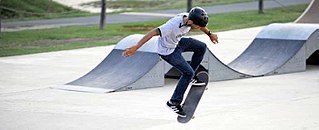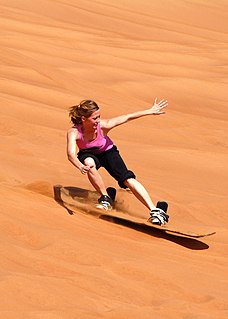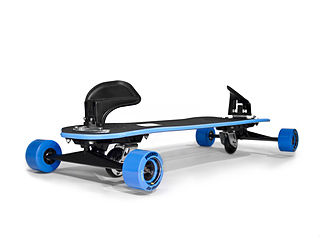
Pineboarding is a recreational activity in which a participant rides down the pine-needle-covered slopes of pine forests on a skateboard deck (without trucks or wheels).

Pineboarding is a recreational activity in which a participant rides down the pine-needle-covered slopes of pine forests on a skateboard deck (without trucks or wheels).
The preferred pineboard is an old school style, highly-concave skateboard deck like those that were popular in the 1970s and 1980s. The edges of concave decks are raised, which provides a much smoother ride. Modern skateboard decks have relatively low concavity and their edges tend to dig into the pine needles and sand while riding.
The underside of the deck is sandpapered down to remove any paint or varnish that it may have. This paint or varnish layer tends to inhibit a smooth ride, as it makes the board stick to the pine beneath it. Floor or wood polish, such as Pledge, is sometimes applied to the underside of the board to provide a more slippery surface.
Another board that has proved itself on this terrain is the Stikboard. This is an all terrain board made out of rotational molded plastic and of a similar size to a skateboard deck. It's lightweight and robust and ideal for grass, sand, snow, and even pine needles.
The pine slopes which are the most sought after are usually those that provide a few clean lines: That is, long sections of slope which provide clear runs without obstacles such as trees, boulders, bushes etc. (a 'run' in pineboarding is simply a single movement from one part of the slope down to another).
Once an agreeable slope has been found, the run or runs have to be 'cleaned'. 'Cleaning' involves removing rocks, small stones, branches, pine cones, and other debris from the run. This is a once-off job so it is important to choose a good slope beforehand. Uncleaned slopes may cause damage to your board, especially from rocks and small stones. It is also nice to know that when you wipe out you'll be landing on soft pine needles and not rocks.
Weather conditions are important to take into account before heading to the forest. If it has rained during the previous week or so, the pine-needles and the underlying sand will still, most likely, be damp. This seriously inhibits the board's ability to slide over the pine-needles. Although these conditions are not preferable, it is still possible to pineboard in such a situation if one applies ample polish before each run.
Unlike most boardsports the movement of a pineboarder is largely determined by the features of the slope. In skateboarding, snowboarding, surfing, wakeboarding and mountain boarding, pressure placed on the edges of the board cause it move accordingly. A pineboard can be directed in this same way, but to a much lesser degree; the primary method is, instead, to adapt one's own movements (degrees of weight distribution on either foot, stance etc.) to the slope.
Proper protection should always be worn, such as a helmet and elbowpads. Because the boarder is moving at high speeds down a steep slope, it can be dangerous if footing is lost or any mistake is made on a trick, i.e. losing the board on a shove-it. This can cause the rider to bail, and on a steep slope, this can cause injury. Bails can also result from hidden obstacles such as rocks and fallen trees. If the rider bails it is important for her/him to get up to a crouching or standing position and stop as quickly as possible.
The run itself and responding to the features of the slope (such as steep angles, corners and drops etc.) is the primary pineboarding experience; but there are a few simple tricks inspired by skateboarding and snowboarding which are performed:
90, 180, 270 or 360 degree rotations: these are performed by swinging the upper-body or lower-body in the intended clockwise or counter-clockwise direction while the feet are in contact with the board and the board is in contact with the slope (a simple move on a snowboard but far more difficult on a pineboard).
A shove-it in pineboarding is basically the same movement as it is in skateboarding. The feet kick the board into a 180 or 360 degree rotation. The board stays in contact with the slope but the feet are in the air above the board as it rotates (originally a skateboarding move).
Ramps are made by building up a mound of sand next to a tree stump. The mound is shaped to give a smooth transition from the slope to the top of the tree stump. The transition slope is then layered with pine needles. Shove-its are performed on the top of tree stump before dropping off the other edge. Cutbacks are performed on the edge of the stump or on the transition slope.
This is almost a cross of a rotation and a shove it. One spins the board under his/her feet and jumps up at the same time thus the board spins under them and the person either spins the same way as the board or in the reverse direction if they want to be fancy.
In pineboarding, thick branches or tree trunks (with diameters ranging from 10 cm to 50 cm) are used to make rails for rail sliding. Fresh branches or trunks are preferred for the slippery riding surface they provide when the bark is removed. Sometimes a little floor polish is applied to rails which have become old and dry.
A pineboarding railslide requires a rail that one can slide directly onto from the slope, i.e. the rail can't be above the ground as it sometimes is in skateboarding and snowboarding. The reason for this is that most pineboards don't have straps or bindings to hold the feet against the board, as in snowboarding. One can't ollie onto a rail as in skateboarding because of the nature of the riding surface and the board.

Board grabs are done the same way as in snowboarding. They are perform from a ramp or drop off. Simply grab the edge of the board on either side. These are performed much more easily if the board has been equipped with bindings.
Many pineboarders now use bindings. It allows for more tricks, including large jumps and better rotations, and more stability. However, bindings do not allow the rider to perform shove-its, and there is more freedom of motion without bindings. Bindings can be made from towstraps to cover the front of your foot. Shoelaces attached to the board can be tightened over the top of the back of your shoe to keep it from slipping out.

Snowboards are boards where the users places both feet, usually secured, to the same board. The board itself is wider than most skis, with the ability to glide on snow. Snowboards widths are between 6 and 12 inches or 15 to 30 centimeters. Snowboards are differentiated from monoskis by the stance of the user. In monoskiing, the user stands with feet inline with direction of travel, whereas in snowboarding, users stand with feet transverse to the longitude of the board. Users of such equipment may be referred to as snowboarders. Commercial snowboards generally require extra equipment such as bindings and special boots which help secure both feet of a snowboarder, who generally ride in an upright position. These types of boards are commonly used by people at ski hills, mountains, backcountry, or resorts for leisure, entertainment, and competitive purposes in the activity called snowboarding.

Snowboarding is a recreational and competitive activity that involves descending a snow-covered slope while standing on a snowboard that is almost always attached to a rider's feet. It features in the Winter Olympic Games and Winter Paralympic Games.

A skateboarding trick, or simply a trick, is a maneuver performed by manipulating a skateboard, usually with one's feet, in a specific way to achieve the desired outcome – the trick.
Boardsports are sports that are played with some sort of board as the primary equipment. These sports take place on a variety of terrain, from paved flat-ground and snow-covered hills to water and air. Most boardsports are considered action sports or extreme sports, and thus often appeal to youth. A large proportion of youth partaking in these sports, together with aesthetic damage to property from sports like skateboarding, has led to many board sports being marginalized by the greater world of sports in the past. However, many board sports are gaining mainstream recognition, and with this recognition have enjoyed wider broadcast, sponsorship and inclusion in institutional sporting events, including the Olympic Games.

The kickflip is a maneuver in skateboarding in which the rider flips their skateboard 360° along the axis that extends from the nose to the tail of the deck. When the rider is regular footed the board spins counter-clockwise if viewed from the back.

Snowshoes are specialized outdoor gear for walking over snow. Their large footprint spreads the user's weight out and allows them to travel largely on top of rather than through snow. Adjustable bindings attach them to appropriate winter footwear.

A half-pipe is a structure used in gravity extreme sports such as snowboarding, skateboarding, skiing, freestyle BMX, skating, and scooter riding.

A terrain park or snow park is an outdoor recreation area containing terrain that allows skiers, snowboarders and snowbikers to perform tricks. Terrain parks have their roots in skateparks and many of the features are common to both.

Sandboarding is a boardsport and extreme sport similar to snowboarding that involves riding across or down a sand dune while standing on a board, either with both feet strapped in or while standing loose, without bindings. Sandboarding can also be practised sitting down or lying on the belly or the back. It typically involves a sandboard, although it is also possible to use sleds, surfboards, a skateboard deck, or snowboards.

A snowskate is a hybrid of a skateboard and a snowboard, intended primarily to allow for skateboard-style tricks on the snow. There are many types depending on the brand or style of snowskate.
Frontside and backside are surfing, skateboarding, snowboarding and aggressive inline skating terms that are used to describe how a person approaches an obstacle or performs a certain trick. In Aggressive Skating, frontside and backside are types of grinds.
A freestyle skateboarding trick is a trick performed with a skateboard while freestyle skateboarding. Some of these tricks are done in a stationary position, unlike many other skateboarding tricks. The keys to a good freestyle contest run are variety, difficulty, fluidity, and creativity. This is an incomplete list, which includes most notable tricks.

A slide is a skateboarding trick where the skateboarder slides sideways either on the deck or the trucks.

A skateboard is a type of sports equipment used for skateboarding. They are usually made of a specially designed 7-8 ply maple plywood deck and polyurethane wheels attached to the underside by a pair of skateboarding trucks.

A freeboard is a specialist skateboard designed to closely simulate the behavior of a snowboard. Freeboards were developed to allow snowboarders to transition to skateboarding without the need to adapt to a smaller deck and narrower wheel-base.
Some Snowboard binding rotating devices are designed to minimize the torque force that occurs when a snowboarder has one foot out of the binding and one locked on the board. The rotating device allows the snowboarder to turn the locked foot straight into the direction of the tip of the snowboard without removing their boot from the boot binding. Like this they can push themselves forward like a skateboarder. Others are designed to be free rotating the entire time you ride. Both feet are free to turn and adjust to the optimal position for a certain terrain. These subtle changes in foot position help keep stress off of ones knees as well as help ones control down the slopes.

Street skateboarding is a skateboarding discipline which focuses on flatground tricks, grinds, slides and aerials within urban environments and public spaces. Street skateboarders meet, skate and hang out in and around urban areas referred to as "spots", which are commonly streets, plazas or industrial areas. To add variety and complexity to street skateboarding, obstacles such as handrails, stairs, walls, flower beds, bins, park benches, picnic tables and other street furniture may be traversed as part of a single trick or a series of consecutive tricks called a "line".
This glossary of skiing and snowboarding terms is a list of definitions of terms and jargon used in skiing, snowboarding, and related winter sports.